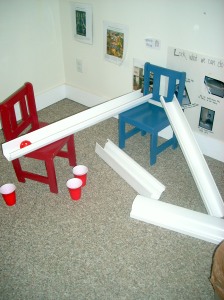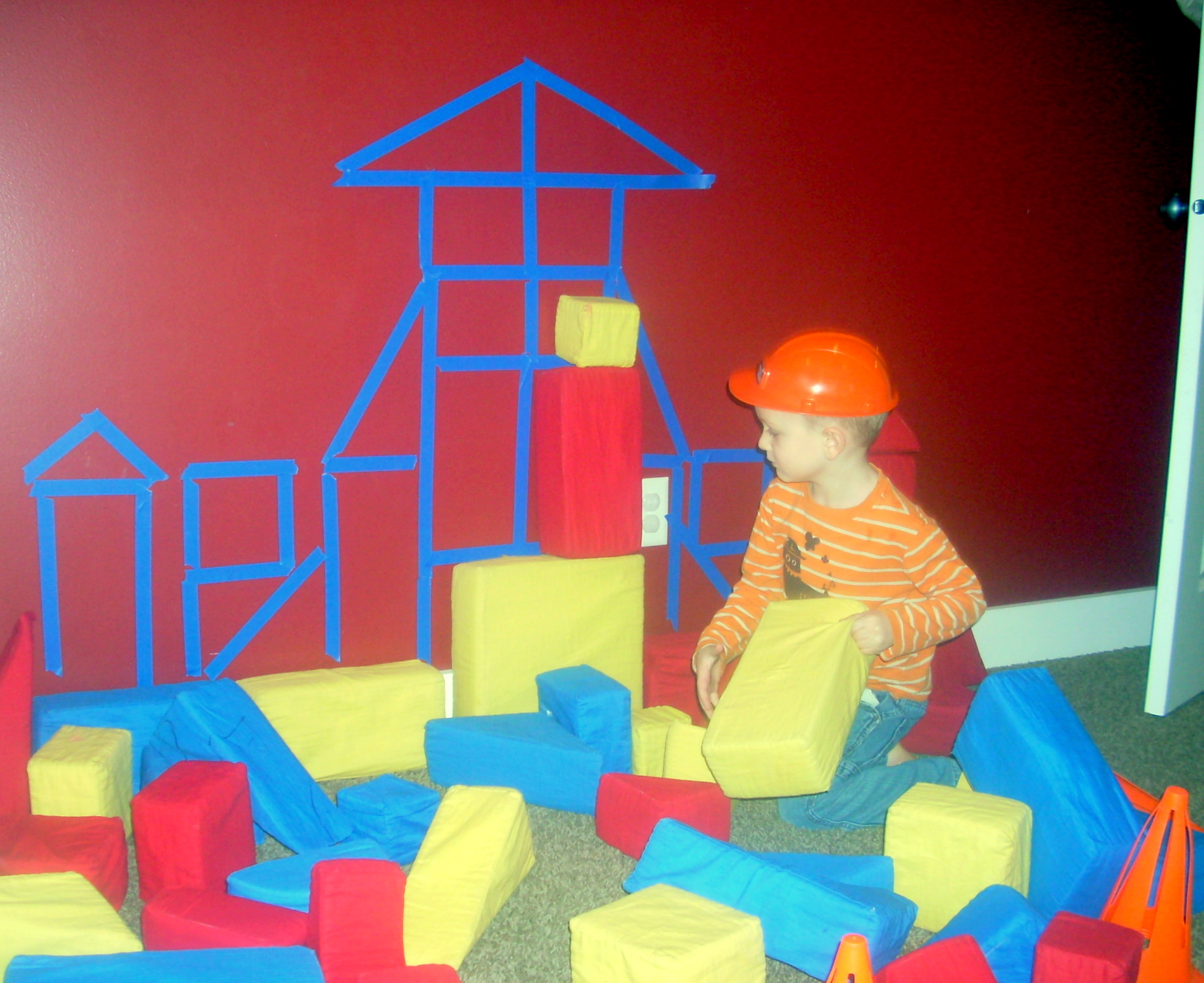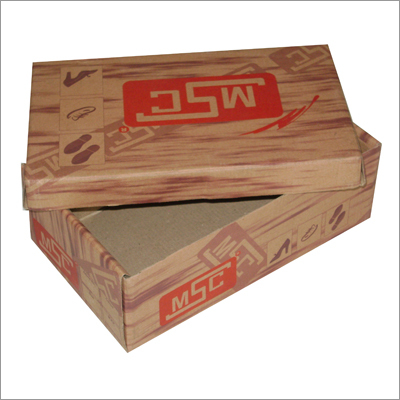This kindergarten group thinks outside the box using Pipe Builders as the building blocks for their outdoor garden.
Sunday, July 15, 2012
This kindergarten group thinks outside the box using Pipe Builders as the building blocks for their outdoor garden.
Blocks Center
The blocks center is a very important part of an early childhood classroom.
In fact, if you had to choose one center in the classroom as the most
important of all, the blocks center would be a prime candidate for the title.
When children build with blocks, they learn about mathematical concepts
such as size, shape, number, and quantity. They become aware of scientific
principles such as the force of gravity and the functioning of simple machines
such as levers and inclined planes. They learn to think, plan, and problem
-solve as their structures take form. This center has special appeal for children
whose intelligences are strong in the visual/spatial, logical/mathematical, and
bodily/kinesthetic areas.
Blocks play provides children with opportunities to create,
cooperate, and communicate. Social learning takes place in the
blocks center as children work together to share materials, space,
and ideas. Literacy skills develop through block play when children
various blocks experiences. Children gain eye-hand coordination and
visual discrimination skills when they group blocks that are the same
size and shape at clean-up time. Virtually everything you might want
to teach a young child can be taught through blocks play!
Labels:
Block Center,
Blocks Play,
Management Ideas,
Teaching Tips
Let’s Build! Activities for a Preschool Tools and Construction Theme
http://notjustcute.com/2011/03/11/lets-build-activities-for-a-preschool-tools-and-construction-theme/
Use a variety of building materials in addition to your standard unit blocks. For examples, kids use pipes, gutters , or large blocks for dramatic play.
 |
| pipes |
 |
| gutters |
 | |||||
| Large Blocks |
Labels:
Block Area Materials,
Blocks,
Blocks Play,
Unit Blocks
Different Props for Different Stages of Block Development
http://progressiveearlychildhoodeducation.blogspot.com/2010/06/we-play-blocks-and-props.html
As with all areas of development, children go through stages using blocks. Understanding the stages will help you to provide the perfect props to appeal to the children in your world.
Carrying Blocks
Watch a toddler in the block area and you will see them carrying blocks around, piling them, collecting them and putting them in and out of containers. To facilitate this play, try adding:
Using Blocks:Early Years Curriculum Materials
This case study is an example of how blocks are used to develop planning, thinking, problem solving
and cooperative strategies in a Prep Year classroom. The prep class is located on a school campus.
Children in this class have usually not attended pre-preparatory classes and have little or no
experience with using blocks in a classroom context.
We have presented this case study in school term units. However, this sequence of teaching and
learning could be adapted according to the needs and interests of the children in your setting.
Block Area Ideas
This is from Gayle's Preschool Rainbow website. It offers some ideas for inexpensive block props.

Cheap Block Play
Materials: Empty boxes - from small shoe boxes to big boxes, such as the ones diapers come in and retail outlet boxes.
Description: Put boxes in the block area where there is room for building and exploring.
Comments: Children love playing with the different shapes and sizes.
Block Time Prop
Materials: Small green containers that strawberries come in.
Comments: Have all of the children save the containers from home.
Unit Block Play
| All About Unit Block Play | ||
| By Nancy P. Alexander | ||
Understanding Unit Blocks
Although there are numerous types of blocks on the market, unit blocks offer the most learning value. What is it about unit blocks that make them such an important part of any early childhood classroom? To begin with, unit blocks are proportional in size to develop mathematical concepts. They are available in various size sets according to the number of children who will use them. Unit blocks are made of hardwood with a natural finish and can therefore be expected to last many years.
Values of Unit Blocks
Children learn many concepts, especially math concepts, through block play. Play with blocks provides an excellent opportunity for social and physical development and enhances creativity. Following is a summary of the specific concepts and traits that children learn through block play:
|
Labels:
Accessory,
block play,
Cognitive,
Creative,
Literacy,
Math,
Physical,
Science,
Social/Emotional,
Unit Blocks,
Value of Unit Blocks
Blocks of Fun! 40 Block Activities for Kids

We tend to have our blocks out a lot around here. Whether itslegos, or wooden blocks, or our ABC blocks, we include them in a lot of the activities that we do.
Blocks are kind of a staple in most households, am I right? Boys and girls both like blocks. They’re a lot of fun!
Turns out, kids can learn a lot from these simple toys. But, what exactly?
Childhood 101 goes into some specifics of adding literacy to the block corner, and Picklebums gives us a little insight onwhy block play is so important to kids.
And I’ve collected some wonderful ways to play with blocks, so we can maximize our use of these awesomely, simple toys[aren't the simple toys the best because they can be used the most ways?].
Here are 40 activities for the kids to do with blocks. I’ve included 14 ideas for the simple wooden blocks, 17 activities for legos [also includes duplo or mega blocks], 4 learning activities for the ABC blocks, and I couldn’t leave out ideas to build with your blocks, so there’s 5 building activities for the kids as well.
Teachers Role 2
A parent might say "How could blocks be important?"
A teacher that does not teach the parents as well as the child, is one that is not prepared. When a parent gets involved with learning it helps the child a great amount. The idea that only the teacher should be involved in a child's learning is a sad cop out. All parents are different, but a teacher should find common ground with every parent so as to make them feel more comfortable and able to help their child learn. Yes, the teacher should be teaching the parent as well. Stressing the importance of Blocks and how they effect every child, where to get blocks and how to join in and facilitate projects at home.
A teacher that does not teach the parents as well as the child, is one that is not prepared. When a parent gets involved with learning it helps the child a great amount. The idea that only the teacher should be involved in a child's learning is a sad cop out. All parents are different, but a teacher should find common ground with every parent so as to make them feel more comfortable and able to help their child learn. Yes, the teacher should be teaching the parent as well. Stressing the importance of Blocks and how they effect every child, where to get blocks and how to join in and facilitate projects at home.
The Teachers Role
The Teachers Role is very crucial to Block Play.
If a teacher does not know much about Blocks or their potential for child development, children will not get as much out of playing with blocks as they could or should. A teachers job is to facilitate and encourage the use of blocks. A teacher can also ask questions about the child's structure so that they may improve and learn more about the type of building they are constructing. The more intricate the child gets with their structure the more they learn.
If a teacher does not know much about Blocks or their potential for child development, children will not get as much out of playing with blocks as they could or should. A teachers job is to facilitate and encourage the use of blocks. A teacher can also ask questions about the child's structure so that they may improve and learn more about the type of building they are constructing. The more intricate the child gets with their structure the more they learn.
Four Preschool Activities for Blocks in the Classroom
written by: Tania Cowling • edited by: Amanda Grove
http://www.brighthubeducation.com/preschool-crafts-activities/51985-four-block-activities-for-preschoolers/
Blocks come in a variety of shapes, colors, and textures so preschool children can use them to learn through their senses. Preschool activities for blocks can also help to develop creativity and problem solving. As you guide the children during block play, talk about the shapes, how blocks are positioned (on top of, underneath, behind), how to balance blocks as in stacking, and counting blocks. Read on for activities that help children explore many concepts in early childhood learning.
Developmentally Appropriate Block Play

By
J. Hendrick|P. Weissman
Subscribe to:
Comments (Atom)